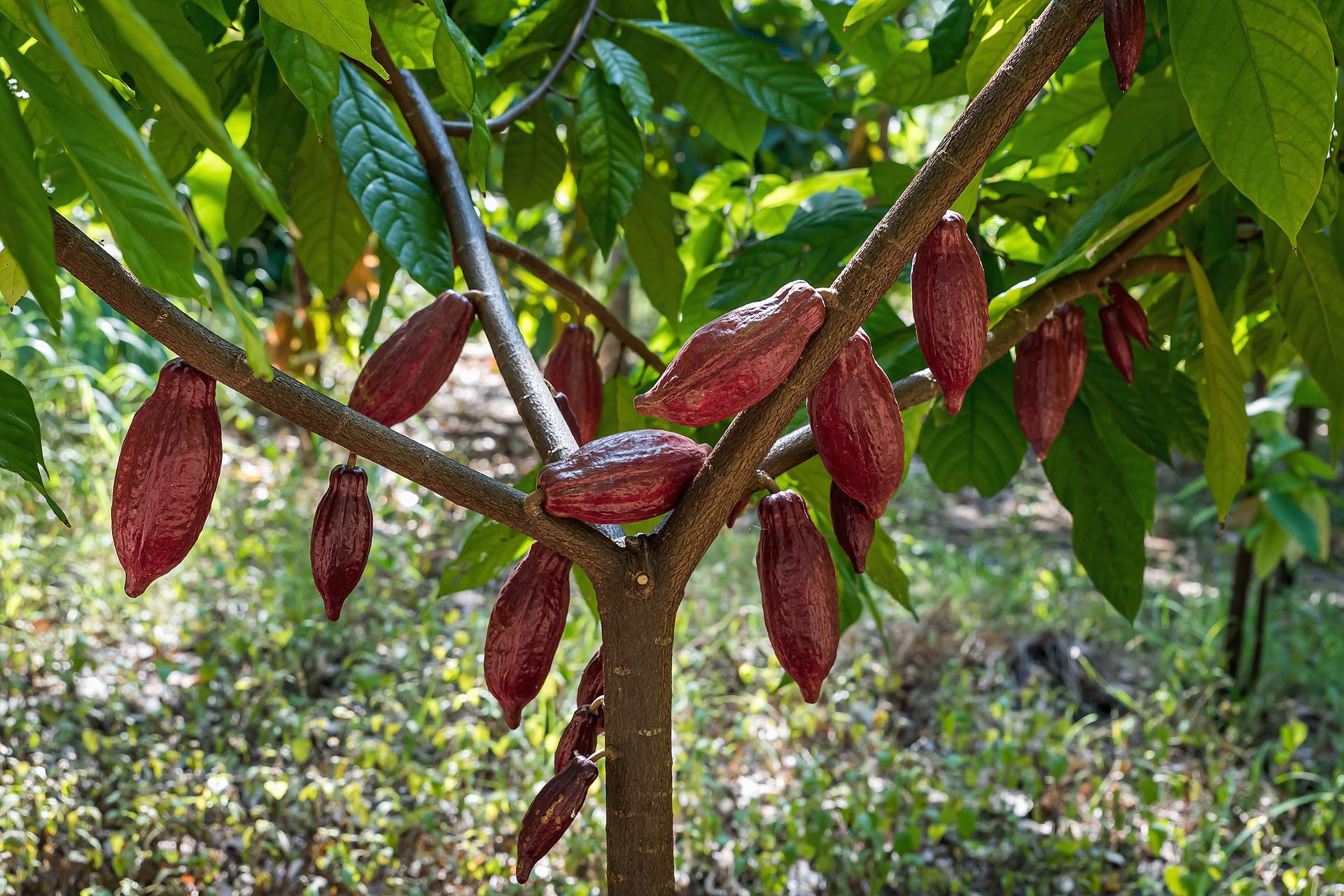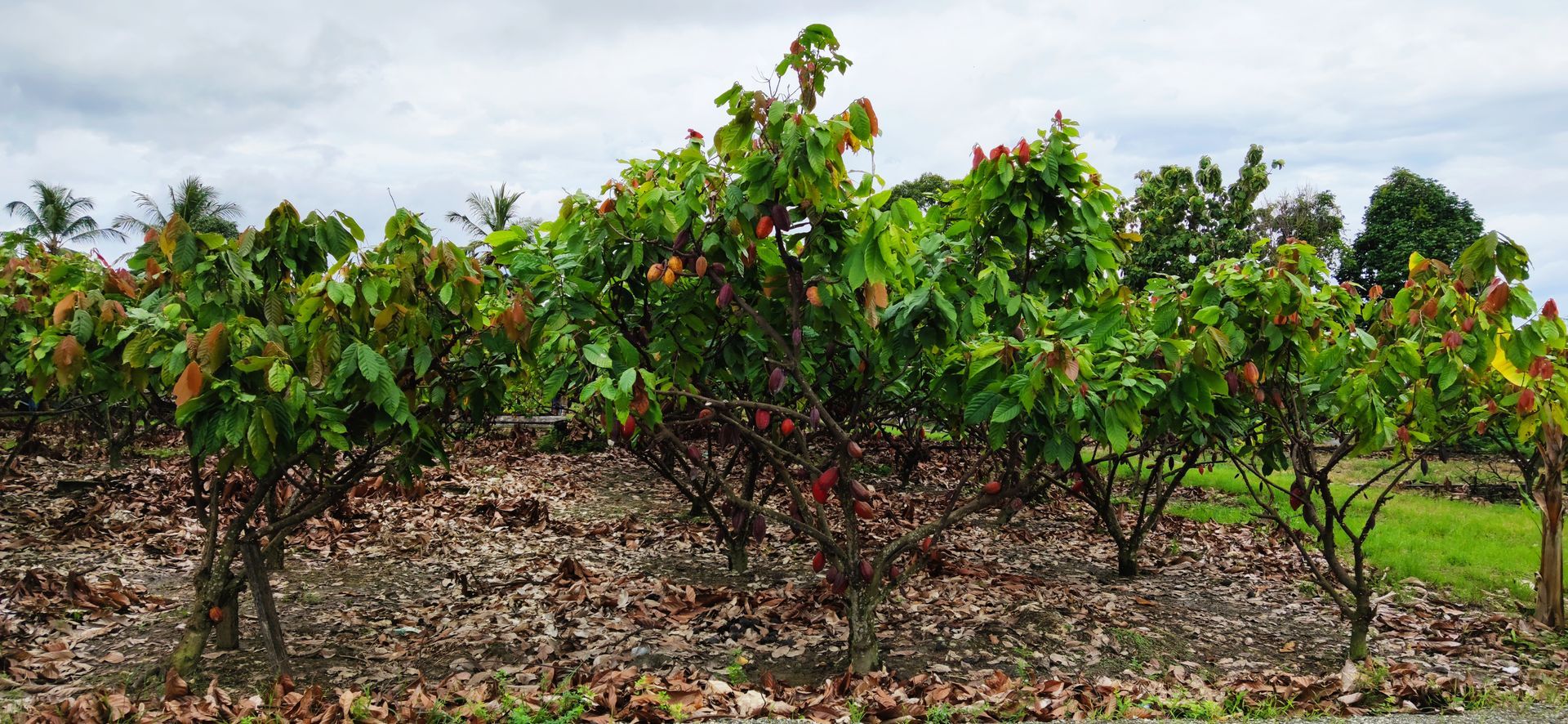Cacao Tree: Everything You Need to Know

Cacao trees are evergreen trees with egg-shaped and leathery leaves. Although they can live for well over 200 years, cacao trees produce cocoa beans for only 25 years. Every year, a cacao tree produces about 40 pods containing cocoa beans, the tree's seeds. These beans are where we get chocolate from. Here's a detailed guide on cocoa tree care.
Fast Facts for the Cacao Tree
| Common Name | Cacao trees, cocoa tree |
|---|---|
| Scientific Name | Theobroma cacao |
| Month(s) of Harvest | First, from May to July, and then October to March |
| Light | Require at least three hours of daily direct sunlight, but also prefer shade from the harsh afternoon sun since it can result in leaf scorch |
| Water | Watering is only needed when the top 1 inch of the soil surface has dried. Potted plants require 0.8 cups of water in nine days when they are shaded from direct sunlight |
| Soil | Require well-drained and slightly acidic soil, with the top few inches - about 5 to 8 inches - requiring amendments, such as topsoil and compost |
| Fertilizer | Fertilizing is required for mature cacao trees twice a year with a fertilizer of the 16:8:24 NPK ratio |
| Pests | Susceptible to attack by thrips, mealybugs, true bugs, cocoa pod borer, and scale insects |
| Diseases | Most commonly affected by pod rots, but is also prone to witches' broom, black pod disease, vascular streak dieback, and cocoa swollen shoot virus |
| Growing Zone | 11 to 12 |
Table of Contents
Everything You Need to Know to Take A Cacao Tree
Whether you're a fan of chocolate liquor or enjoy the cocoa powder in your baking sessions, every type of chocolate you use comes from cacao beans. These beans grow as seeds on cacao trees. Here's what you need to know about growing cocoa trees.
Planting
The Theobroma cacao tree needs a hot tropical climate with a temperature range of 65-90°F for proper growth. It also needs a lower elevation, anywhere under 2,000 feet. The tree thrives in an area with ample rainfall and good soil drainage. The area should get about 40-100 inches of yearly rainfall for best growth.
Cacao trees only grow in limited areas called the Chocolate Belt or the Cocoa Belt. The area extends twenty degrees south and north of the equator, mainly covering the tropics.
A quick look at the map of the US would tell you that most of the country is 30 degrees from the equator, making it difficult for you to grow a cacao tree on the mainland.
But it's possible to grow cacao trees in Hawaii, Southern Florida, and Central and South America. In fact, Hawaii is right in the Cocoa Belt.
If you live in Hawaii, you should plant the tree in the fall or spring. A cacao tree grows fairly slowly and will take about five years to produce seed pods.

Care and Maintenance
Cacao trees grow well in the right water, sun, temperature, and humidity conditions. Pruning cacao trees is also important to maintain their shape. Here are the right conditions for optimal fruit production.
Sun and Temperature
Cacao trees prefer a temperature range of 65 to 90°F (18–32°C). If the temperature falls below 50°F (10°C), the tree can sustain significant damage to its structure and fruit production.
A cacao tree should get about three hours of direct sun every day. Plant the tree in an area where it's shaded from the afternoon sun to prevent leaf scorch.
Water and Humidity
Cocoa plants thrive when there's a consistent level of moisture in the soil. So, you should water the plant when the top inch of the soil surface dries out. However, do not water too much, as soggy soil can cause root rot.
High humidity is also important for optimal cacao tree growth. The tree needs about 75 to 86% of relative humidity during the day and 51 to 72% in the afternoon.
Soil
Cocoa plants prefer porous soils with good drainage. Most commercial growth takes place on sandy and clay loamy soils. Make sure the soil is slightly acidic with a pH of 6.5 to 7.
Fertilizing
When mature enough to reproduce, cacao trees need 0.4-1.2 kg (1-3 lb) of fertilizer twice a year. Opt for a fertilizer with a 16:8:24 NPK ratio. Such a fertilizer has:
- 16% nitrogen
- 8% phosphorous
- 24% potassium
It's best to use a fertilizer with additional micronutrients, such as magnesium, zinc, manganese, and calcium.
Pruning
You must prune your cocoa plant twice a year. First, prune after the harvest from April to July. Second, prune a few months later, in November or December.
Pruning the cacao tree is important because it makes your pest control and fertilizing measures more effective. It also enhances vegetation growth, which leads to more yields. Other objectives of cacao pruning are:
- Height control
- Production of a well-balanced structure
- Aeration promotion
You'll only need handheld or powdered saws to prune a cacao tree. Do not use cutlasses or machetes.
Start the pruning process by only cutting the damaged, infected, and dead branches. After that, remove the branches that are very close to each other. You can cut according to the shape you want the tree to take. Do not cut more than one-third of the tree in one pruning session.
Propagation
You can propagate cacao by cuttings or seeds. Cuttings come from young and healthy trees. If you have a cacao garden, you can take cuttings from young trees at a right angle above the node with about 3 to 9 leaves.
Remove the leaves at the bottom of the cutting and put the base of the cutting in propagation media, such as coconut husk with rooting hormone.
Alternatively, you can use seeds. They are planted at stake. In this case, you put three seeds in a hole. Germination takes about 15 days.
After that, remove the seedling with the tap root. Place the seedling in a pot filled with soil and water regularly.
Did You Know? Ghana and Côte d'Ivoire produce most of the world's cocoa, about 60%.
Harvesting and Storing
Cacao trees undergo harvesting twice. The main harvest has a higher yield, while the secondary harvest produces fewer pods. A cacao pod can be about 15 to 30 cm long and have 30 to 50 beans.
Harvesting
The cacao pods containing beans grow from the branches and trunk of the tree. To harvest, cacao farmers remove the pods from the tree and open them to get the beans out. You can use a sharp blade to cut the pods off the tree.
If the pods are too high up, use a pruning hook. Push or pull the pods, depending on the fruit's position, to make a clean cut that doesn't damage the branches bearing the pods.
Open the beans in about 7 to 10 days after the harvest. Using a wooden club is the easiest way to do this. Strike the pod's central area with this club to split it into two.
Remove the beans from the pods using your fingers. Some growers may also use machetes to split the pods, but these tools often damage the beans inside.
Farmers also use machinery for this step. But if you're only growing a single tree, you can do this part manually.
Storing
After the harvest, cocoa beans are fermented. There are different methods to ferment cocoa beans, but they all involve putting the beans together to allow microbe action on them. The seeds are covered with banana leaves.
How long you ferment the cocoa seeds will depend on the seed type. For example, Criollo beans only need 2 to 3 days for fermentation, while the fermentation period for the Forastero brand is 5 days.
The next step is drying. In this process, the moisture level of the beans is reduced from 60% to merely 7.5%. There are two ways to dry cocoa beans:
- Sun drying
- Artificial drying with fuel dryers
Cocoa beans must be given sufficient time to dry completely. If you dry them too quickly, they may develop an acidic and bitter flavor since fermentation chemical reactions do not have enough time to occur.
Meanwhile, if you dry them too slowly, they may be off-flavored. Some studies show the right temperature for drying cocoa plant beans is 65ºC.
You can then store the beans in airtight containers, such as plastic bags, until you're ready to use them. Then, use them to make cocoa butter or other chocolate goods.
Common Issues With Cacao Trees
Growing cocoa plants is not as easy as being a chocolate lover. The evergreen tree is susceptible to several problems that can result in cacao fruit decline and poor growth.
Growing Problems
The main problem with growing cacao trees is that they are not suited for all environments. Growing mainly in tropical rainforests, these tropical plants do not survive in cold weather and extreme temperatures. Other climates, like areas with heat during the night and strong winds, can also make it difficult for them to thrive.
Pests
Several insect pests affect cacao tree growth. Here are some of them.
Black Pod
Caused by Phytophthora megakarya and Phytophthora capsici, the condition leaves translucent spots on the cacao pod surface. The pod can become necrotic and black in just two weeks of the first symptoms occurring.
The best way to contain these pests is to spray copper fungicides on cacao trees. When planting trees, keep sufficient space between them for proper circulation. Remove and destroy the affected pods to prevent the pest from spreading.
Scale Insects
Scale insects suck sap from the trees using their sucking mouthparts. They can cause the leaves to wilt and result in the plant's stunted growth. In extreme cases, it can be lethal to a tree.
Get in touch with your local horticultural authority to be a part of their chemical eradication program for scale management.
Diseases
The following viral and fungal diseases also affect cacao trees, affecting plant growth and pod production.
Cocoa Swollen Shoot
Although the viral disease is not native to cacao plants, it can affect chocolate-producing trees in West African regions. The symptoms include:
- Red leaf veins
- Chlorotic patches on the leaves
- Shoot swelling
- Leaf swelling
- Swelling on the steam at internodes and nodes
In severe instances, removal of the infested trees is the only way to keep other vegetation safe.
Witches Broom
Witches' broom is caused by Moniliophthora perniciosa, resulting in cacao branches not producing fruit. The disease can also distort pods and cause green patches to appear on them. Remove the trees and branches infected by the fungus to prevent spread.
Sweet New Earth's Final Word On Cacao Trees
Cacao Trees are great trees to plant if you are looking for a new challenge in the garden. Be sure to follow these quick care tips and you will be able to raise your tree well.
FAQs

Christina Hernandez
Christina has done most of her research on environmental science but recently has changed her focus towards sustainable forestry. She has a passion for the outdoors and wants to spread that passion to the world.
Join our community!
Join to receive guides, insights, and the latest gardening deals!
